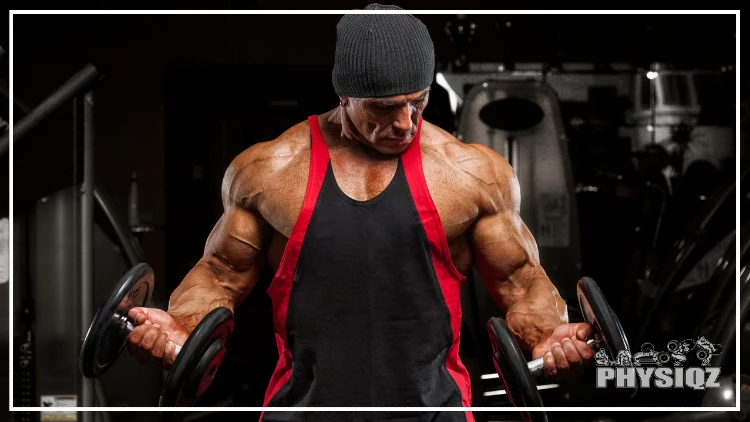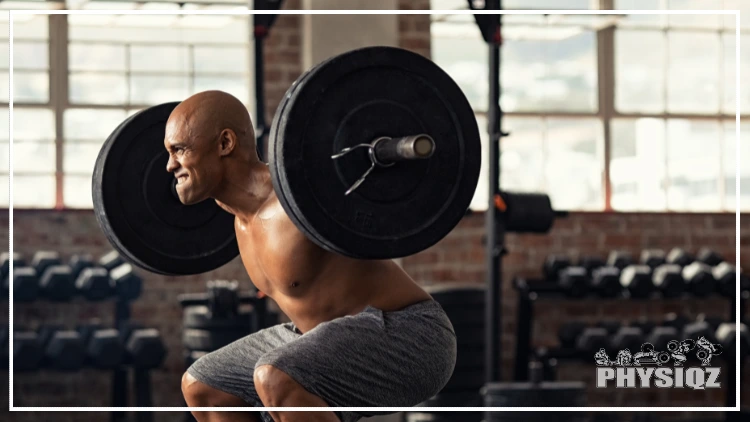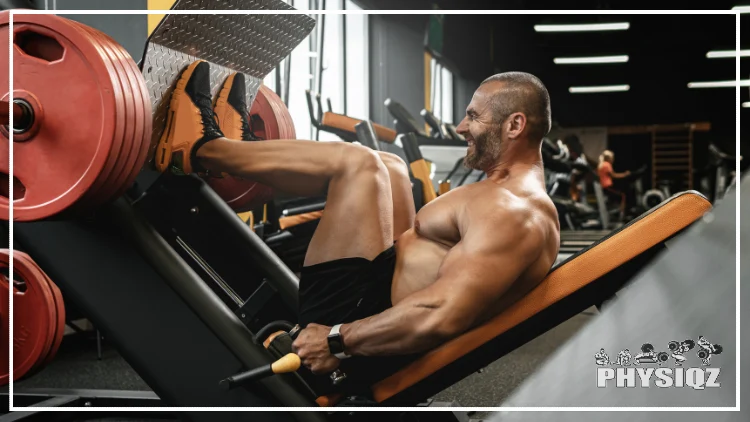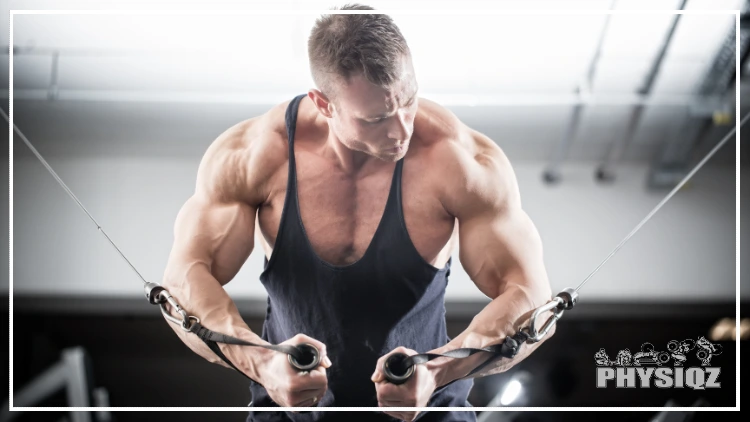
A 5 day powerbuilding split is possibly the best program to build strength and size at the same time because it incorporates both bodybuilding and powerlifting types of training with high frequency.
Or in other words, this 5 day program emphasizes strength through compound movements and throws in hypertrophy training too so a lifter doesn’t have to choose between size or strength.
By using this five day powerbuilding program, any lifter can maximize volume week over week and hit every compound life 2x per week – which is exactly why this program became the #1 most popular program.
Why Is a 5 Day Powerbuilding Split the Best for Mass & Strength?
A five-day powerbuilding routine combines the best aspects of strength and hypertrophy training, incorporating compound movements for building strength and high-rep accessory exercises for muscle growth.
Powerbuilding programs come in several forms and the premise behind it is that it is to use compound lifts such as bench press, squat, overhead press, and deadlifts with movements more associated with bodybuilding like curls, leg press, lat pull downs, and good mornings. Since every training day is not solely focused on the core compound lifts, fatigue is kept at a manageable range and more frequent sessions, such as a 5 day training split, are more viable.
Powerbuilding incorporates intense, low-rep compound exercises to boost strength, similar to powerlifting. This includes the weekly volume of a powerlifter where the goal is to target lifts instead of muscle groups, such as two training sessions of bench press, two squats, and one deadlift (because deadlifts can be extremely taxing on the body).
Accessory work, or exercises that compliment the main lifts, will be formatted more like a bodybuilder where muscle groups are focused. The idea is to have higher reps to build up weekly volume and thus, increase muscle mass. Depending on how the program is built, these accessory movements can be designed to directly benefit the main compound movements or address weak points in physique, again having the cake and eating it too.
A five-day powerbuilding routine effectively combines the best elements of a hypertrophy program with powerlifting principles, maximizing results from both approaches.
However, on the other side of the coin is the fact that a powerbuilding split lacks specificity since it does not target bodybuilding or powerlifting exclusively and for this reason, beginners should try another program like Starting Strength or Ivysaur’s 4-4-8 Program.
Core Concepts of Strength Training & Hypertrophy Training for Mass
To effectively design a powerbuilding program, aspects of strength training and hypertrophy training need to be optimally addressed and this includes the best rep ranges for mass, hypertrophy, and strength.
Hypertrophy Training
While benefiting from compound lifts as well, can be better targeted with isolation movements. Hypertrophy training tends to be more fatiguing in individual body parts since volume per body part is higher and thus, rest can be shorter.
Reps to illicit hypertrophy are equally achieved through a wide range of reps, 5 to 30 reps, with a wider range of intensities, 65% and higher.1 Weekly training volume for hypertrophy falls between 12 and 28 sets per muscle group and weekly training volume.2
Strength Training
Strength revolves around maximal effort lifts and requires more compound movements throughout the training process. Strength training can be highly systemically fatiguing (basically fatiguing for the entire body) and as a result, usually requires longer rest times.
Reps for strength training are usually lower, 3 to 10 reps, and with higher intensity, 80% 1RM or higher. Unfortunately, strength does not receive the same benefit from weekly volume as hypertrophy training so between 10 and 12 sets per movement (bench, squat, and deadlift) are suitable.3
How The 5 Day Powerbuilding Program Works
Powerbuilding programs come in multiple varieties and can be formatted in many different ways.
Some powerbuilding programs have more powerlifting-centric days and more bodybuilding-centric days. Some other programs have a powerlifting component for the first half of the workout and then switch to bodybuilding movements afterward.

Source: Rido via Canva.com4
Consider the following examples: For the days that split strength days and hypertrophy days, a lifter may do bench press, bent over rows, and kroc rows on one day and then do tricep push downs, lat pull downs, and lateral delt raises.
For days that have both strength and hypertrophy, a training session might start with a bench press, then move to bent-over rows, then move to skull crushers, lat pull downs, and bicep curls.
By having the strength and hypertrophy movements on the same day, the exercises can be coordinated. If a lifter is having a leg day, they can start with back squats and then move to exercises such as leg extensions to help develop their quads further for the squat. If the lifter is focused on strength then their accessories will support their squat, if they are focused on hypertrophy, then more of their accessory focus will be an exercise that develops lacking parts of their legs.
When designing powerbuilding programs, it’s essential to consider specific factors. Firstly, identify whether the primary goal is strength or hypertrophy. The priority goal will determine which exercises are emphasized in the program.
Secondly, a five-day workout routine is generally not ideal for beginners. Typically, beginners benefit more from training each body part once a week.5 Therefore, a five-day schedule might be too intense for those new to lifting. Additionally, powerbuilding programs require a balanced approach to strength and hypertrophy training, which is less effective with lower frequency splits.
How to Use RPE or RiR in a Powerbuilding Split
We’ll dive into the details below, but incorporating RPE and RiR in lifting involves autoregulation, a crucial tool for advanced high-volume training routines such as a five-day powerbuilding program.
Autoregulation is a tool that lifters use to manage fatigue and effort in every training session. Autoregulatory tools are most often paired with a weekly training volume system to reduce the chances of a lifter succumbing from mental fatigue hampering their gains. The most common tools for autoregulation are reps in reserve (RiR) and rate of perceived exertion (RPE).
RiR is how many reps a lifter still has in the tank. For example, if a lifter is doing 8 reps at RiR 2, they should pick a weight they can do for 10 reps but stop at 8. For the vast majority of training, anything between 0 and 4 RiR will be effective for strength and hypertrophy.
RPE is similar to RiR but is a broader system that can be applied to lifting and endurance training. For lifting, RPE works on a 1-10 system where 1 is not exertion at all and 10 is maximal effort. When using RPE for lifting, it is helpful to tie RPE to RiR, so RPE 8 would be the same as RiR 2.
For this 5 day powerbuilding split, RiR should be between 1 to 4 for each exercise, but RPE is a valid autoregulation tool as well.6 The RiR ranges of 1 to 4 provide enough stimulus to develop strength and size. As a lifter gets closer to the end of their mesocycle, 4 to 8 weeks training period, typically their intensity increases and their RiR will usually go down. So near the end of the mesocycle, a lifter should be working closer to RiR 1 to 2 than 3 to 4.
The 5 Day Powerbuilding Split Program for Strength & Size
The following power-building program uses an upper-lower split, training sessions will be focused on upper body movement days and lower body movement days. Upper body days will be focused on improving the bench press while the lower body days will be focused on improving the back squat and deadlift.

Source: A’s Images via Canva.com7
Each workout will be using an agonist-antagonist format or doing one movement type and then moving to the opposing group next, for example, bench press and then bent over rows. Both the back squat and the bench press will be performed twice a week and the deadlift is performed once a week to keep the fatigue from the deadlift low.
Accessory movements compliment the core exercises while addressing muscles that may not receive as much stimulus during the core moments. So without further ado, here’s the program that will get you stronger and bigger:
Day 1: Lower Body 1
- Core Lifts
- Back Squat (4 x 5 @ 80% 1RM RiR 2)
- RDLs (4 x 6 @ 75% 1RM RiR 3)
- Accessory Lifts
- Leg Press (4 x 12 @ 65% 1RM RiR 3)
- Bulgarian Split Squats (4 x 12 Each Leg @ 65% 1RM RiR 3)
- Cable Pull Throughs (4 x 12 @ 65% 1RM RiR 3)
- Leg Extensions (4 x 12 @ 65% 1RM RiR 3)
Day 2: Upper Body 1
- Core Lifts
- Bench Press (4 x 5 @ 80% 1RM RiR 2)
- Bent Over Rows (4 x 6 @ 75% 1RM RiR 3)
- Accessory Lifts
- Dumbbell Incline Press (4 x 12 @ 65% 1RM RiR 3)
- Chest Supported Rows (4 x 12 @ 65% 1RM RiR 3)
- Skull Crushers (4 x 12 @ 65% 1RM RiR 3)
- Hammer Curls (4 x 12 @ 65% 1RM RiR 3)
Day 3: Lower Body 2
- Core Lifts
- Back Squat (4 x 5 @ 80% 1RM RiR 2)
- Hip Thrusts (4 x 6 @ 75% 1RM RiR 3)
- Accessory Lifts
- Goblet Squats (4 x 12 @ 65% 1RM RiR 3)
- Good Mornings (4 x 12 @ 65% 1RM RiR 3)
- Calf Raises (4 x 12 @ 65% 1RM RiR 3)
Day 4: Upper Body 2
- Core Lifts
- Bench Press (4 x 5 @ 80% 1RM RiR 2)
- Overhead Press (4 x 6 @ 75% 1RM RiR 3)
- Accessory Lifts
- Lat Pull Downs (4 x 12 @ 65% 1RM RiR 3)
- Dumbbell Shrugs (4 x 12 @ 65% 1RM RiR 3)
- Dumbbell or Cable Y Raises (4 x 12 @ 65% 1RM RiR 3)
- Cable Face Pulls (4 x 12 @ 65% 1RM RiR 3)
Day 5: Lower Body 3
- Core Lift
- Deadlift (4 x 5 @ 80% 1RM RiR 2)
- Accessory Lifts
- Kettlebell Swings (4 x 12 @ 65% 1RM RiR 3)
- Hamstring Curls (4 x 12 @ 65% 1RM RiR 3)
- Dumbbell RDLs (4 x 12 @ 65% 1RM RiR 3)
Day 6: Rest day
Day 7: Rest day
Continue days 1-7 for four weeks and deload for at least one week on the fifth week. In addition, the RiRs listed here are estimates for the first week of training, but by week 4, RiRs should be closer to 2-1.
The format of this sample splits lower body days and upper body days by at least 48 hours. This will allow the body to recover before training the same movement again so the maximal effort can be performed for each core lift.
The deadlift is placed at the end of the week so the body can fully recover over the next two rest days, but the deadlift can be shifted to the first day of the training week if it is the priority so it can be performed while fresh.
Of course, the upper lower training split can be broken down and reformatted in many ways and there are other powerbuilding-esque 5 day a week programs like the PHAT workout too.
Progressive Overload: Periodizing Volume for Maximum Returns in Any Powerbuilding Routine
Taking advantage of periodization to supercharge your gains through the use of a progressive overload can lead to achieving any goal you desire in time. Progressive overload and periodization are mandatory to make any program as effective as it can be.
What Is Progressive Overload & Periodization
Progressive overload is the process of overloading a muscle so the body responds by making the muscle bigger and stronger.8 This process is controlled by the use of regulating training volume and intensity. Progressive overload is the base function that all good programs are founded on.
Progressive overload occurs on a week to week basis over the course of a larger chunk of time such as a macro- or mesocycle, explained shortly. Each week, training volume needs to increase whether by intensity (for more strength focused gains) or by reps (for more hypertrophy focused gains).
Should the lifter wish to take this training sample and continue with it, some important factors should continue. Firstly every program needs to progress and induce progressive overload, or the program should increase in volume over time, such as increasing reps or intensity or both over time.
Periodization is taking a long training period and dividing it into smaller more focused chunks. It is divided into macrocycles (6 months to years), mesocycles (4-8 weeks), and sometimes, microcycles (1 week). Within a macrocycle, several mesocycles of training will be performed going over different focuses.
The first mesocycle should always be hypertrophy then the next can be focused on hypertrophy again, strength, muscular endurance, or peaking (attempting to reach full potential at any given period of time.
Implementing Progressive Overload in a Five-Day Powerbuilding Routine
There are two main ways to progress a program: linear and undulating periodization, periodization being having focused mesocycles for progression.
Linear Progressive Overload
Linear progression comes in many forms, but at the base, there is a consistent increase over time, such as adding 5lbs to each lift every week or adding 1 rep each week. Basic linear works very well for beginners since their body is adjusting and their increases in strength are more due to neurological adaptations, or their nervous system is becoming more efficient at exercise, than muscle efficiency improvements. More advanced lifters are usually unable to utilize basic linear progression because their neurological improvements are minor, so they would benefit from other kinds of linear progression.
Since the five-day powerbuilding routine is better suited for advanced lifters, alternative linear progression methods like wave-linear and step-load linear may be more effective options. Wave-linear uses smaller cycles within the mesocycle that are effective for aggressive strength gains. Wave-linear will increase intensity each week (for example, 70%, 80%, 90%) and once 90% or higher is achieved, the lifter calculates their new max and repeats.
Step-load is similar to wave-linear but instead of increasing intensity, the lifter will increase reps. So for example, in the first week they may do 4 reps of the bench, then 6 reps, then 8 reps. Once they can achieve 8 reps, they will increase the weight and repeat the next three weeks. Step-load is a slower process than basic linear and wave-linear but increases in strength are more sustained and consistent.
Daily Undulating Progressive Overload
Undulating progression uses a different system to a linear progression but does not yield significantly different results to the linear progression system, or simply, its personal preference to pick undulating or linear.9 In an undulating progression, training days are divided by intensity such as very light (50-60% 1RM), light (60-70% 1RM), moderate (70-80% 1RM), heavy (80-90% 1RM), and very heavy (85-95% 1RM) and are distributed over a mesocycle, sometimes randomly. Depending on goals will dictate the frequency of each intensity day, for example, if a lifter is focused on hypertrophy, they would have more moderate and heavy days as opposed to the others.

Source: Kzenon via Canva.com10
For an undulating progression program, each intensity should be balanced. There is very little reason to stack a week with 2 heavy days and a very heavy day within the same week. Likewise, unless the lifter is taking a deload, a break from heavy lifting to allow the body to recover, there is no reason to have several very light and light days within the same week. Some may prefer to have every intensity represented every week but rotate which workouts will be under which training intensity.
Also, each training intensity does not need to be represented. Some daily undulating programs do not include a very light day and some do not include a very heavy day, but considering this is an article over powerbuilding, it is better to include some very heavy days.
In very advanced daily undulating programs, individual lifts may be assigned to different intensities. The back squat may be assigned to be very heavy while RDLs are assigned to be light all in the same day. The reason for this, is because it is advised to not attempt a program that has squats and deadlifts on the same day unless the lifter has a deep understanding of programming, or their coach does.
For powerbuilding, the progression system should focus on the core lifts since they will dictate the rest of each training session. Of course, the accessory lifts should also progress, but they can progress by using a general linear increase in reps and weight as long as RiR 1-4 is achieved.
Applying Periodization to the 5 Day Powerbuilding Split
Periodization is the division of training into smaller states.11 Periodization for linear progression and daily undulating progression is not too different from one another but the differences still exist.
Linear Periodization
To apply linear progression to the preview above, most lifters should start with a mesocycle focused on hypertrophy, but the beauty of powerbuilding is even when a lifter is training for size, they are accumulating experience under heavier loads so when they move to strength focused mesocycles.
Start with a mesocycle focused on slightly lower intensity and having more reps. This allows the body to slowly prepare for when the intensity and volume ramp up towards the end of the mesocycle. Over the course of the mesocycle intensity should increase or overall weight should increase, depending on if they are using a basic linear program or an advanced version.
Once the first hypertrophy mesocycle is complete, then the lifter should decide if they want to do another hypertrophy mesocycle or if they want to move to strength or peaking (testing their current peak ability). Always start with the hypertrophy mesocycle. This provides the body to adapt to technique and volume requirements while adding additional muscle for use in the strength phase if that is the next mesocycle.
Daily Undulating Periodization
To apply an undulating progression system works similarly to the linear progression, except instead of a general increase in intensity. Undulating uses frequencies to benefit certain goals. During the hypertrophy mesocycle, the majority of training days should be focused on moderate or heavy intensities. At least ⅓ of training days should be moderate intensities.
After the first hypertrophy mesocycle, the lifter has to select to do another hypertrophy mesocycle or move to a strength mesocycle. If they shift to a strength mesocycle, then they should have the majority of training sessions should be heavy intensity. In the peaking phase or competition prep for powerlifting, most of the days should be heavy intensity days.
Each time the lifter moves to the next mesocycle, if hypertrophy or strength, a viable option is to increase all intensities by 5%, allowing for the continual increase in strength over time, or calculate their new 1 rep max to adjust all their off of.
One of the greatest benefits of a powerbuilding program is that it can easily transition to other goals. For example, say a lifter just finished his 8 week mesocycle of a 5 day a week powerbuilding program and decides that he wants to start training for powerlifting. He can easily shift to a 8 week powerlifting program right after to start preparing to compete in powerlifting and this works the same if he wanted to transition to bodybuilding.
Powerbuilding programs, while not for the faint of heart, and an extremely effective tool in any lifter’s arsenal. The 5 day powerbuilding split is still growing in popularity among lifters and will be the #1 training split for powerbuilding for many years to come.
References
1Schoenfeld, B. J., Grgic, J., Ogborn, D., & Krieger, J. W. (2017). Strength and Hypertrophy Adaptations Between Low- vs. High-Load Resistance Training: A Systematic Review and Meta-analysis. Journal of strength and conditioning research, 31(12), 3508–3523. <https://doi.org/10.1519/JSC.0000000000002200>
2Krzysztofik, M., Wilk, M., Wojdała, G., & Gołaś, A. (2019). Maximizing Muscle Hypertrophy: A Systematic Review of Advanced Resistance Training Techniques and Methods. International journal of environmental research and public health, 16(24), 4897. <https://doi.org/10.3390/ijerph16244897>
3Mang, Z., Germain, J. S., & Kravitz, L. (2022). Volume Training for Hypertrophy. University of New Mexico. Retrieved September 16, 2022, from <https://www.unm.edu/~lkravitz/Article%20folder/VolumeHypertrophy.html>
4Rido. “Man Lifting Weights at Gym.” Canva. Accessed 11 April 2023. <https://www.canva.com/photos/MADdwgBinVU-man-lifting-weights-at-gym/>
5Mang, Z., & Kravitz, L. (2022). Best Frequency for Hypertrophy. The University of New Mexico. Retrieved September 16, 2022, from <https://www.unm.edu/~lkravitz/Article%20folder/frequency.html>
6Lagally, K. M., McCaw, S. T., Young, G. T., Medema, H. C., & Thomas, D. Q. (2004). Ratings of perceived exertion and muscle activity during the bench press exercise in recreational and novice lifters. Journal of strength and conditioning research, 18(2), 359–364. <https://doi.org/10.1519/R-12782.1>
7A’s Images. “Bodybuilder Doing a Seated Leg Press Exercise in a Gym.” Canva. Accessed 12 April 2023. <https://www.canva.com/photos/MAE2-gMUdmQ-bodybuilder-doing-a-seated-leg-press-exercise-in-a-gym/>
8Virginia Tech University. (2017). PRINCIPLES. strength.org.vt.edu. Retrieved September 16, 2022, from <http://www.strength.org.vt.edu/principles.html>
9Harries, S. K., Lubans, D. R., & Callister, R. (2015). Systematic review and meta-analysis of linear and undulating periodized resistance training programs on muscular strength. Journal of strength and conditioning research, 29(4), 1113–1125. <https://doi.org/10.1519/JSC.0000000000000712>
10Kzenon. “Bodybuilder Doing Butterfly on Cable Pull.” Canva. Accessed 12 April 2023. <https://www.canva.com/photos/MABiE2pvmNI-bodybuilder-doing-butterfly-on-cable-pull/>
11Hall, A. (2014, February 28). Periodization In Strength Training: What Is It And How Can You Use It? – Recreation. Recreation. Retrieved September 16, 2022, from <https://recreation.gmu.edu/2014/02/periodization-in-strength-training-what-is-it-and-how-can-you-use-it/>